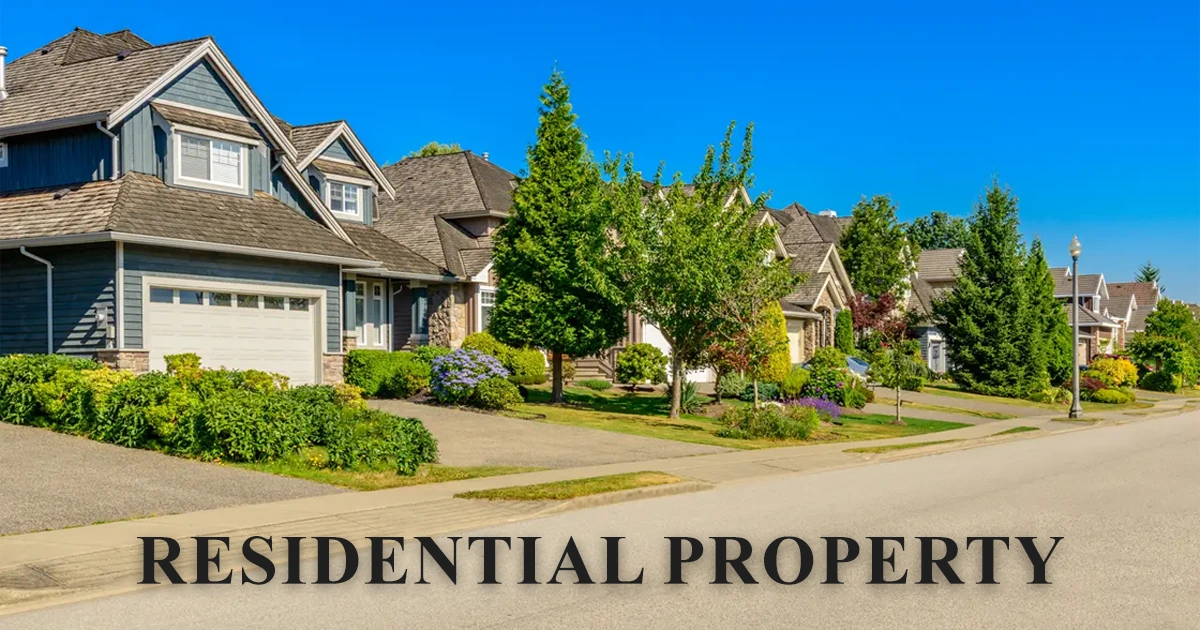Residential property, most of the time, refers to homes such as houses and apartments, perhaps even a villa or two. But in real estate, there’s a much deeper meaning to residential property. It’s not just a building that people live in; it’s a classification that affects how one can use the space, what taxes one will pay, and even how much the investment might grow.
If you’re looking for examples of residential property, wondering about GST on residential property, or looking up different types of residential properties before buying, knowing what it is is the first step toward smart decision-making in the housing market.
Residential Property Meaning
Residential property, in simple words, is real estate primarily for living purposes. It is constructed for human habitation, be it permanent or temporary.
Standalone houses, flats, villas, bungalows, and some rental properties qualify as residential properties, as long as they serve as a place to live.
Legally defined, what constitutes residential property differs from one jurisdiction to another, but it usually means that land or a building is to be used for dwelling purposes. It is generally not allowed to be used for other large-scale business or industrial operations without special permissions.
Also Read: Mortgaged Property Meaning, Sale, Gift Rules & Legal Steps in India
Familiarity with the different types of residential property becomes imperative at the time of deciding on the location and means of investing.
Independent Houses – Standalone buildings that are constructed on a plot of land, which grants full legal rights over the land along with the structure. It is one of the best property forms for those who need privacy and a bit more space.
Apartments – They have more units under one system and use common amenities like lifts, parking areas, and recreational spaces together. Mostly, they sell in urban areas due to space scarcity.
Builder Floors – A residential unit in a low-rise building; generally, one flat per floor. It is more private than an apartment but still gives urban ease.
Duplex & Triplex Homes – homes that are multi-storeyed within a single unit and fit larger families.
Studio Apartments – a small space suitable for an individual or young professionals, living, sleeping, and cooking within the same space.
Residential Plots– Unbuilt land that is earmarked for private dwelling places; these lands give additional rights to buyers who may then construct houses based on their tastes and within the statutory provisions of the area where they live.
Also Read: Low Rise vs Mid Rise Buildings: Which Defines Modern Living?
Residential Flat Meaning
A residential flat is an individual unit housing space located within a multi-storey edifice that has been purposely constructed for residential living. In places such as Mumbai, Delhi, or even Bangalore, flats were the best option since there’s hardly any open space and most of the areas are overpopulated.
Mostly flats are part of a housing society or apartments where owners share common amenities like security, elevators, and parking spaces. The meaning of residential flat is relevant while applying for a home loan because banks have different guidelines as far as financing is concerned with such types of properties.
Key Features of Residential Property

These are the common attributes that most residential properties share:
Usage- Primarily for inhabitation or living.
Zoning Laws- Must abide by the local residential zoning laws.
Types of Ownership- Freehold or leasehold.
Facilities- Usually have facilities such as water and electricity supply, security, and recreational spaces.
Rent Income Potential- These properties may be let for residential purposes only, except under special permission.
Also Read: Flat vs Apartment: What’s the Real Difference? A Complete Guide
GST on Residential Property
GST’s implementation in India has clarified how residential property transactions would be taxed. Here are some important facts on GST in connection with residential property:
Under-Construction Residential Property: For affordable housing projects (1% GST rate-no Input Tax Credit) and for non-affordable housing construction (5% GST-no Input Tax Credit).
Ready-to-Move-In Residential Property: Taxes don’t apply to the use of GST if the completion certificate was given prior to the sale.
Criteria for Affordable Housing under GST rules: Carpet area of 60 sq. m or less in metro cities and 90 sq. m in non-metro cities; Value less than or equal to ₹45 lakh.
This GST channel is clearer for the buyers, and to some extent, reduces costs in some segments.
Difference Between Residential and Commercial Property
Both are real estate assets, but the distinction is in their primary purpose:
| Aspect | Residential Property | Commercial Property |
| Purpose | For living purposes | For business operations |
| Examples | Flats, houses, villas | Shops, offices, warehouses |
| Zoning Laws | Residential zoning | Commercial zoning |
| Taxation | Lower GST rates | Higher GST rates |
These differences will avoid legal problems regarding property purchases for the buyers.
Why Understanding Residential Property Matters?
Learning the essence of it would help inform the first-time home buyers, renters, and even investors in making sound investment decisions by:
- Understanding its tax implications, more so concerning GST.
- Compliance with zoning and all other usage laws.
- Assess returns and future income from the asset through rental income or resale.
Therefore, it is referred to as any real-estate that is intended to be occupied by humans as a permanent dwelling. It might consist of anything starting with independent houses, flats and villas to land plots. Before one decides to invest on any residential house it is important to understand what is meant by residential property, different forms of it
Whether you are looking at tiny apartments in the inner cities of India, or vast mansions in the suburbs, the Indian housing market has it all and more. The understanding of the meaning and its types allows one to make solid decisions explained in 2025 and afterwards.




